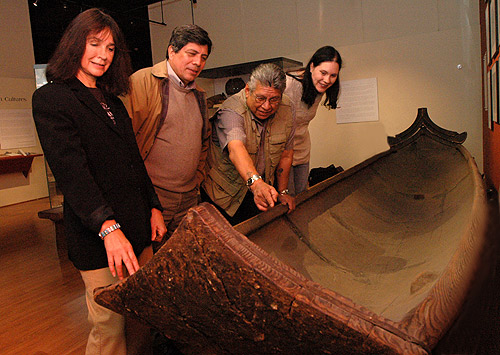Berkeleyan
 Hearst Museum Cultural Attaché Otis Parrish, third from left, discusses a Yurok redwood dugout canoe with NAGPRA-unit colleagues Larri Fredericks, Anthony Garcia, and Natasha Johnson. (The unit's coordinator, Richard Hitchcock, is not pictured.) The canoe, collected by Berkeley anthropologist Alfred Kroeber in the early 20th century, can be found in the museum's Native California Cultures Gallery. (Peg Skorpinski photo) |
Native Staff at the Hearst Museum's NAGPRA unit
Larri Fredericks, Anthony Garcia, and Otis Parrish
![]()
Larri Fredericks
Senior Museum Scientist Larri Fredericks grew up in a Native village in central Alaska, population 250. She "inherited her strong personality," she says, from her Swedish father, a first-generation American and her Tanana Athabascan mother, who always reminded her that their tribe was matrilineal. With no public library in town, and no television until the late 1960s, Fredericks devoured magazines and remaindered paperbacks that her sister brought home from her job at the general store.
After graduating from high school (her generation was the first to do so), she enrolled in the University of Alaska at the urging of the former village priest who was studying anthropology there, making her the first in her family to attend college. After two years she transferred with a scholarship to UC Santa Barbara, only telling her family about it once she'd been accepted.
California proved a distant and lonely place, however, for a young Athabascan woman ("I left school many times to return to Alaska," she recalls). Her morale improved once she found a handful of fellow Native students from UCSB, after putting an ad in a newspaper, and together they helped found the campus's American Indian recruitment program.
Fredericks came to Berkeley in 1974 and studied under Heinrich Blum, the "father of health planning." After receiving her master's degree, she did public-health work with Indian organizations in the Bay Area, then returned to Berkeley to get a doctorate in medical anthropology. A mother of two teenagers at 56, she also chairs the advisory committee of the American Indian Graduate Program, whose annual commencement for American Indian/Alaska Native graduate students includes the bestowal of a traditional Indian Pendleton blanket to each graduating student.
With two Berkeley degrees and two blankets to her name, she jokes that she needs to go to law school. "I could use a third one."
Anthony Garcia
Anthony Garcia is an Apache who is the NAGPRA unit's newest senior museum scientist. Migration and resettlement were the focus of his anthropological research when studying for his Ph.D. in Berkeley's anthropology department in the 1980s.
"My interest had in part stemmed from my many years of community service with San Francisco Bay Area urban Indian organizations," he says. "I had worked hard to help the youth and adults who had difficulties adjusting to urban life…. I became interested in what in people's minds motivates them to move to cities, and why some individuals are successful and some fail."
Garcia's own family had moved from rural Arizona to Southern California in the 1940s to find work. When he first came to Berkeley as an undergrad, in 1969, there were only five or six Native students on campus, he recalls. An activist by nature, he helped start two "very ideological" student-sponsored classes on American Indian issues (which became the starting point for the campus's Native American Studies program); he also helped plan the occupation of Alcatraz Island by "Indians of all tribes" and participated in the occupation during the initial weeks of that historic action.
After teaching for many years, Garcia joined the Hearst Museum's NAGPRA unit eight months ago. "The more I work here, the more I realize how important it is for Native people to have these things given back to them," he says. "I'm wondering if someone's going to close the door on this great experiment."
Otis Parrish
As cultural attaché in the NAGPRA unit, Otis Parrish plays many roles — from tour guide to ambassador to writer and editor. But "jack of all trades" is something he's comfortable with — having worked, in the course of his career, as a watch repairer, lumber-mill worker, heavy-equipment operator, archaeological technician, and social worker.
Parrish grew up on the Kashaya Pomo reservation, on the north Sonoma coast, where he attended grammar school in a one-room schoolhouse. A high-school dropout, he was making good money in construction work in the 1970s when he heard about a program at Sonoma State University that helped minority students get their education. "I love risk-taking," he says, so he decided to "go out on a limb" and seize the opportunity.
The first in his family to go to college, Parrish designed his own curriculum in California Indian history, with a minor in anthropology, and later came to Berkeley as a graduate student to study anthropology and archaeology. Here he began to work with Professor Kent Lightfoot, doing research on the group of Kashaya Pomo who were forcibly brought to Fort Ross in 1812.
Members of Parrish's large extended family, including his mother, opposed his participating in archaeological work at the fort. "We have an issue with disturbance of the earth," he explains.
Parrish's idea was that by using tribal ceremonials, it would be possible to do excavation at the site (which seemed to him the only way to go beyond what he could learn about his tribe through written history) while honoring Kashaya Pomo traditions. The conversation took decades, he says, but the community eventually agreed. "I've broken new ground in terms of our people looking at our history," he says.
In 1999 Parrish became only the second American Indian to be hired by the Hearst Museum, after Ishi, who died in 1915. He calls his work there on repatriations "not only unusual, but very soul-satisfying."

